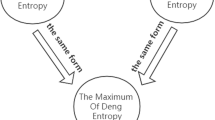Abstract
This paper uses the compatible probability functions to define the notion of upper entropy and lower entropy of a belief function as a generalization of the Shannon entropy. The upper entropy measures the amount of information conveyed by the evidence currently available. The lower entropy measures the maximum possible amount of information that can be obtained if further evidence becomes available. This paper also analyzes the different characteristics of these entropies and the computational aspect. The study demonstrates usefulness of compatible probability functions to apply various notions from the probability theory to the theory of belief functions.
Preview
Unable to display preview. Download preview PDF.
Similar content being viewed by others
References
D.P. Bertsekas, Constrained Optimization and Lagrange Multiplier Methods, Academic Press, Inc., New York, pp. 71–75, 1982.
C.W.R. Chau, P.J. Lingras and S.K.M Wong, Upper and Lower Entroipes of Belief Functions, Technical Report, Department of Computer Science, University of Regina, Sask., Canada, 1990.
A. Dempster, Upper and Lower Probabilities Induced by a Multivalued Mapping, Annals of Mathematical Statistics, 38, pp. 325–339, 1967.
D. Dubois and H. Prade, Properties of measures of information in evidence and possibility theories, Fuzzy Sets and Systems, 24, 1987.
Fagin, R. and Halpern, J. (1990). A New Approach to Updating Beliefs, Proceeding of the Sixth Conference on Uncertainty in AI, Cambridge, Mass., July 27–29, pp. 317–325.
S. Guiasu, Information Theory with Applications, McGraw-Hill, London, 1977.
J. Hartmanis, The Application of Some Basic Inequalities for Entropy, Information and Control, Vol. 2, pp. 199–213, 1959.
IMSL, Nonlinearly Constrained Minimization Using finite-different gradient, IMSL Math/Library User's Manual, pp. 895–908, 1987.
G.J. Klir and T.A. Folger, Fuzzy Sets, Uncertainty, and Information, Prentice Hall, Englewood Cliffs, NJ, 1988.
P.J. Lingras, Qualitative and Quantitative Reasoning Under Uncertainty in Intelligent Information Systems, Unpublished Ph.D. Dissertation, Department of Computer Science, University of Regina, Sask., Canada, 1991.
P. J. Lingras and S.K.M. Wong, Two Perspectives of the Dempster-Shafer Theory of Belief Functions, to appear in The International Journal of Man-Machine Studies, 1990.
J.R. Quinlan, Inductive inference as a tool for the construction of high-performance programs, Machine Learning, R.S. Michalski, T.M. Mitchell and J. Carbonell eds. Palo Alto, CA: Tioga, 1983.
G. Shafer, A Mathematical Theory of Evidence, Princeton. N.J.: Princeton University Press, 1976.
G. Shafer, Belief functions and possibilities measures, The Analysis of Fuzzy Information 1, Bezdek, J.C., CRC Press, 1986.
C.E. Shannon, A mathematic theory of communication, Bell Technical Journal, Vol. 4, pp. 379–423, 1948.
H.E. Stephanou and S. Lu, Measuring Consensus Effectiveness by a Generalized Entropy Criterion, IEEE Transactions on Pattern Analysis and Machine Intelligence, Vol. 10, No. 4, pp. 544–554, July 1988.
S.K.M. Wong and P.J. Lingras, Unification of the Bayes Conditionalization and the Dempster Rule by Minimizing Information Gain, to appear in The proceedings of the Sixth Conference on Uncertainty in AI, Cambridge, Mass., July 27–29 1990.
S.K.M. Wong, W. Ziarko and R. Le Ye, Comparison of rough-set and statistical method in inductive learning, International Journal of Man-Machine Studies, 25, pp. 53–72, 1986.
R.R. Yager, Entropy and Specificity in a Mathematical Theory of Evidence, International Journal of General Systems, Vol. 9, pp. 249–260, 1983.
Author information
Authors and Affiliations
Editor information
Rights and permissions
Copyright information
© 1993 Springer-Verlag Berlin Heidelberg
About this paper
Cite this paper
Chau, C.W.R., Lingras, P., Wong, S.K.M. (1993). Upper and lower entropies of belief functions using compatible probability functions. In: Komorowski, J., Raś, Z.W. (eds) Methodologies for Intelligent Systems. ISMIS 1993. Lecture Notes in Computer Science, vol 689. Springer, Berlin, Heidelberg. https://doi.org/10.1007/3-540-56804-2_29
Download citation
DOI: https://doi.org/10.1007/3-540-56804-2_29
Published:
Publisher Name: Springer, Berlin, Heidelberg
Print ISBN: 978-3-540-56804-9
Online ISBN: 978-3-540-47750-1
eBook Packages: Springer Book Archive




